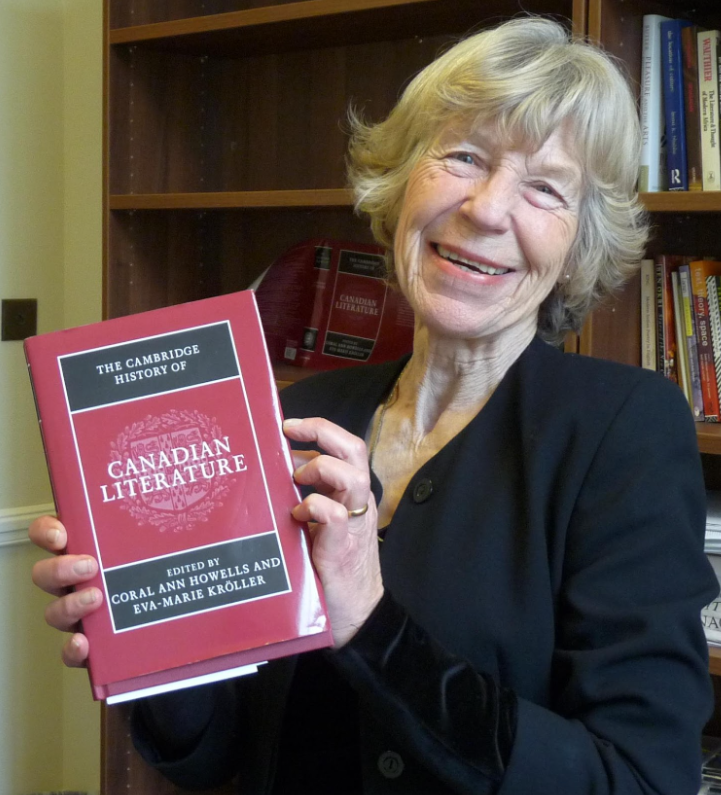By Professor Coral Howells
The Handmaid’s Tale is Margaret Atwood’s most popular novel. Its popularity has increased with the recent Hulu and MGM television adaptations, which form a part of the context within which her book is now read. We also have Atwood’s sequel, The Testaments (2019). The novel, the TV series and The Testaments form a continuum, all part of the 'Handmaid phenomenon', where the Handmaid image in its various reinventions has become embedded in popular culture. The Handmaid’s Tale is our starting point, for the text does not change – though the cultural frame within which we read it has shifted. By restaging Atwood’s 1980s dystopia in a different medium in contemporary America, the TV series convinces us of the novel’s relevance as a fable for our times, where the same social and political anxieties are updated. As Atwood said when she wrote the book, 'Nothing inconceivable takes place, and the projected trends on which my future society is based are already in motion.' This is speculative fiction, not science fiction, written as a warning against possible futures as dystopias always are. It is also a warning against indifference, as Atwood commented in 2022, 'Anything can happen anywhere, given the right conditions, as history has demonstrated time and again.' (Burning Questions, p.251) Her comment chimes with our present historical moment, and the Handmaid phenomenon centres on her key themes: abuse of power, threats to human rights (especially women’s rights) and the need for a counternarrative of resistance in the hope of survival.
How has the TV adaptation shifted the meanings of the novel?
An adaptation is 'a creative and an interpretive act of appropriation, an extended intertextual engagement with the adapted work' (Linda Hutcheon, A Theory of Adaptation, p.8). As separate artefacts using different technologies, the novel and the TV series conform to different conventions. The storyline in the series stretches beyond the novel as it introduces new subplots investigating the lives and deaths of individual characters only hinted at by Atwood. New characters appear (Offred’s second daughter is born in the second series) and contemporary Gilead is a multiracial society. There is not much here that Atwood’s novel does not foreshadow: from forced childbearing, child kidnappings and surrogacy, to the persecution of racial and sexual minorities, religious fanaticism, the erosion of civil liberties, pollution and climate change. No wonder, then, that The Handmaid’s Tale has spilled over from fiction into the real world, where Handmaids’ red cloaks have become the international symbol of women’s protest. Gilead’s oppressive laws are Atwood’s reminder of the fragility of freedoms that many democracies enjoy.
Characterisation: different but the same
The most striking difference between the novel and the TV series is the characterisation of Atwood’s Handmaid, Offred, played by Elisabeth Moss in the TV version, for they are very different kinds of resistance heroines. We may unconsciously picture Atwood’s Offred with Elisabeth Moss’s face, since Offred gives only a blurred mirror image of herself as 'a wraith of red smoke'. But there is no risk of confusing the two if we pay attention to the central importance of Offred’s voice in the novel, where her witty interior monologue and her narrative self-consciousness construct a relationship with the reader that is more intimate than on-screen dialogue. These heroines share similar irrepressible energies, but their very different behaviour presents the concept of female heroism from two different perspectives.
Atwood’s exclusive focus on Offred’s perspective in the novel shifts so that in the complex storytelling mode of the TV series, the Handmaid’s voice is diffused among many others’. Though there are frequent shots of Elisabeth Moss’s face in extreme close-up, she is no longer the isolated protagonist directly addressing 'You', the reader or listener.
Offred in print
In the text, Atwood stages a confrontation between Gilead’s totalitarian narrative of domination and the visceral power of one woman’s counternarrative of witness, resistance and hope for survival. She uses the testimonial form, for 'The power of witness narratives is immense, especially when combined with artistic power.’ Whereas Elisabeth Moss’s Offred is feisty and rebellious, the original knows that she has no agency in Gilead – only 'the power of a dog bone, passive but there'. There is a difference between abjection, complicity and rebellion, and 'printed' Offred’s is a story of passive resistance centred on her living body, conscripted into state service but also the source of her vitality. She believes that she still has rights as a human being, and she adopts the classic feminine resistance strategy of refusal: declining to believe Gilead’s ideology or to forget the past. Telling her story is an act of hope, and Offred hopes for many things. She hopes to be reunited with her lost husband, Luke, and their stolen daughter, and she hopes for escape, though she is acutely aware of her precarious circumstances: 'In hope, as they say on the gravestones.’ (The Handmaid's Tale, p.205). Offred’s story in the novel – and in the TV series (as this article is written) – is unfinished. Like so many handmaids’ stories, though, she remains hopeful as she steps into the Black Van: 'And so I step up, into the darkness within, or else the light.’ (p.307) Hope is a dynamic force for individual and collective survival, endorsed by Atwood in the futuristic Historical Notes after Gilead has fallen and Offred’s narrative is finally delivered.
Endnotes
- Atwood, Margaret. The Handmaid’s Tale. Vintage, 2005
- Atwood, Margaret, Burning Questions, Chatto & Windus, 2022
- Hutcheon, Linda. A Theory of Adaptation, Routledge, 2012
________________________________________________________________________________________________________________
Biography:
Coral Ann Howells is Professor Emerita, University of Reading, and Senior Research Fellow, Institute of English Studies, University of London. She is editor of the Cambridge Companion to Margaret Atwood, co-editor of the Cambridge History of Canadian Literature and co-editor of the Oxford History of the Novel in English, volume 12. She is a Fellow of the Royal Society of Canada.
